
The Burning of Honganji Temple —Osaka, 11 September 1580

Oil on canvas, 65×80cm, c.2010-2021, M.Tsushima
Buddhist powers were Nobunaga's greatest enemies. One of them, the strongest, was Honganji Temple with that Nobunaga made war for ten years. After four years of siege of Osaka, the Honganji sanctuary, in 1580 the Honganji agreed to the armistice, and left Osaka. Then the temple caught fire and flared up.
Background
In 1568 Nobunaga marched his army to Kyoto to support Ashikaga Yoshiaki to be enthroned to be Shogun. For the campaign he required to Honganji for donation for military support. Since then Nobunaga put pressure on Honganji which grew hostility against Nobunaga. In 1570 when Nobunaga's Army marched in the north of Osaka to attack hostile warlord, Miyoshi, Honganji suddenly made uprising against Nobunaga who was to retreat to Kyoto.
Since then war on Osaka broke out intermittently.
In the spring of 1576, Honganji troops of fifteen thousand believers attacked Nobunaga's troops stationed at Osaka. Nobunaga immediately counterattacked and subsequently began the siege of the Osaka Honganji Temple Castle which was fortified with moats and earthworks, and surrounded by 51 redoubts.
The Honganji called for help from all over the country. Believers gathered to defend the redoubts around the Osaka castle, Honganji's allied western warlord, Mori Terumoto, sent six hundred boats to defeat Nobunaga's Navy to supply Osaka in 1576.
But two years later Nobunaga's Navy was reinforced by Kuki's fleet to block the Osaka Bay and made Osaka hard to survive, though the Osaka Castle was still hard to capture by force.
Nobunaga sought to make an armistice by the intervention of the Imperial Court. In April 1580, he required Honganji to leave Osaka. The chief priest of Honganji, Kyonyo, agreed to the armistice, and left the Osaka Castle. Under the administration of the imperial envoys, the handing over of the castle was supposed to be conducted peacefully, but during the evacuation, the temple caught fire and flared up. In the following days and nights the buildings were all burnt down.
Accounts
Ota Gyuichi(1527-1613), a samurai who served Nobunaga, writes[1]:
For the first place, Osaka is almost the best place in Japan. Specifically, it is near Nara, Sakai and Kyoto; especially, waterways provide direct access from Yodo and Toba to the Osaka Castle Gate. Meanwhile, there are choke points on all sides: in the north, many great rivers, Kamogawa, Sirakawa, Katsuragawa, Yodo, Ujigawa, flow. Within 5 to 7 miles, rivers like Nakatsugawa, Suitagawa, Eguchigawa, Kouzakigawa, flow around. In the southeast, the mountains like Kamigadake, Tatsutayama, Ikomayama, Iimoriyama, watch further mountains. At their foot, Domyoji River and Yamato River flow into the newly built moat, joined by streams through Tatsuta Valley. Within 7 to 10 miles to the foot of Osaka, it flows far through bays and rivers in succession. In the west spreads blue ocean full of water, in that navigate ships not only from lands in Japan but also from China, Korea and southern countries. The five provinces and the seven highways of Japan gather here for commerce and profit, making it a wealthy port.
Honganji believers from the neighboring provinces gathered together, inviting castle builders from Kaga province, built up a fort in 0.9 km square, in the middle of that was a high terrain. Hear the sect erected a dazzling "Hall on the Water", in front of that was a pond full of water on which lotus leaves grew to symbolize union of believers to rebirth in afterlife, behind that was a vessel to symbolize helping believers cross the ocean of life and death. The front of the altar of Buddha was lit up. Reciting the name of Amida Buddha corresponds to a sharp sword which extinguishes bandits of worldly desires, enemies of enlightenment. Setting up houses in the sacred place of the prosperity of Buddhism, with their tiled roofs lined up, their eaves connected, the smoke of wealth is thick, generally respecting the teaching, day and night Buddhist pilgrimage from far lands continues on the road.
While the sect was expected to live perpetually, some years ago, when Nobunaga attacked Noda and Fukushima, the sect, unexpectedly agitated by an evil spirit, thought that when the forts fell, Osaka also was to be attacked, and, though they were Buddhist monks, raised an army, and blocked the road. Then Nobunaga retreated the troops from Noda and Fukushima. Perhaps because he did not forget the grudge, Nobunaga, already five years ago, blocked the pilgrims to the temple, furthermore captured them as enemies, blocked each gate, and arriving at Tennoji ordered Harada Bichu to build a redoubt.
Honganji, seeing that the construction of the redoubt was yet to complete, immediately organized an army, sent them to Tennoji, and made a battle, killed Harada Bichu, Hanawa Kisaburo, Hanawa Koshichiro, Minoura Muuemon and so on, and kept up momentum to besiege Tennoji. Nobunaga mobilized a small troop as a reserve army. In that day, Nobunaga fought two battles and defeated Osaka at the both battles, killed many. It was a deep regret that the large army was captured by the small enemy.
However, the latter days came, wrath of fighting spread, Osaka as well, despite its lack of force, built 51 redoubts, Takasu, Maruyama, Hiroshiba, Masayama and so on, barricaded themselves inside the wall where they collected rice tax of 50,000-goku. Leaving their fate to deity, they defended for five years, but the defenders became weak day by day, plot and stratagem did not work. Meanwhile, Nobunaga was so glorious that he secured the provinces and seven highways of Japan.
Now that an edict was issued and justice cannot be evaded, the sect agreed to leave the castle. Since Osaka began its foundation here, 49 years passed, as if yesterday's dream, contemplating the course of the event, the manner of life-and-death, vicissitudes is quite ephemeral like a lightning or a morning dew, There is nothing comparable to chanting the name of Buddha single-mindedly as a sharp wisdom, and with this merit reaching a spiritual awakening. However, now, people high and low, fretting about leaving home, are deeply in tears.
Then, expecting that after leaving Osaka Nobunaga would come to see this place, the sect ordered maintenance and cleaning nooks and crannies, at the front weapons like bows, spears, firearms, are hanged in line, inside, materials and goods are checked and neatly placed. The castle was handed over to the imperial envoys and magistrates, On August 2, 14:00, hundreds of boats were called from Saika and Awaji Island to pick up the people including those who were in recent years deployed at the redoubts. They, turning to their relatives, departed hither and thither, both on sea and land as if baby spiders spread, The time has finally arrived, and the westerly wind blows over the torch fire, burning down plenty halls, leaving none of them, for three days and nights, they burned to become a black cloud.
A Buddhist monk of Kofukuji Temple, Tamonin Eishun (1518-1596), writes[2]:
On August 2nd, Osaka Castle was handed over. The Imperial officer might have prepared to burn it down after receiving it; It was all mercilessly burned down in the night of the 2nd and until the dawn of the 3rd. Affluent rice, salt, miso, materials were all lost by fire; it is the damage to the country. It is said that Honganji believers high and low had fled to Saika. It is around the time of the uprising in 1532 that they left Yamashina and arrived at Osaka, where they for 48 to 49 years enjoyed the prosperity and wealth brought from all country. Now in a short period of time it is ruined, having seen the rise and fall.
Venue
Honganji Temple was at the center of today's Osaka Castle site, where was called Ishiyama, a height overlooking Yodogawa River at its northern foot.

It was 1496 when Honganji Temple Dojo was founded by the eighth Honganji Chief Priest, Rennyo(1415-1499). At that time there were no houses around; there were only fields.
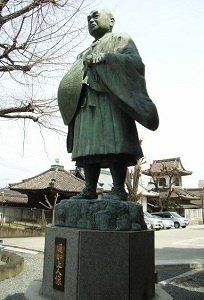
Thereafter, towns around the temple were built and the population grew, especially after 1533, when the Osaka Honganji Temple became the center of the Honganji Temple after the former center, Yamashina Honganji Temple, was destroyed in 1532 in the war against samurai warlords. The defence of the town was the priority. From 1534 to 1538, major moats were built around the town. It was followed by the construction of religious buildings; From 1542 to 1548, several buildings including major two halls, Amidado-Hall, Goeido-Hall, were constructed.
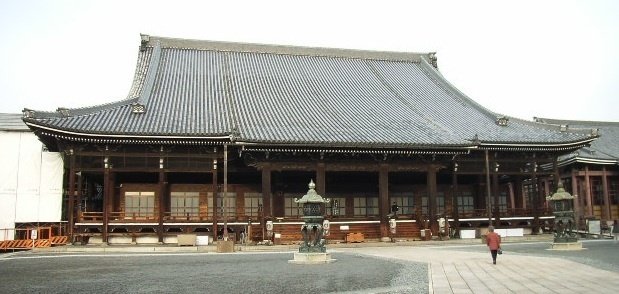
The Osaka Honganji temple developed to be a sanctuary of believers across Japan. Since the time of the eighth Chief Priest, Rennyo, who promoted the propagation of Honganji Buddhism, the Honganji had huge number of believers in the western japan, especially in the northern coastal provinces, Echizen and Kaga. The believers made a pilgrimage to Osaka, Traffic by river and land made Osaka a center not only of Buddhism but also of commerce. A Jesuit missionary, Gaspar Vilela, writes:
Most of the wealth of Japan is owned by this monk. Every year, they have an extremely vigorous festival, when many people visit it; they wait in front of the gate, compete to enter the temple at once so eagerly that many of them are killed... In the night, the monk makes a preach and many people shed tear. In the morning, a bell is rung to signal for morning service, everyone enters the hall.
Around the temple site, six towns with 2,000 houses were built. In the town lived various workers: architects, craftsmen, blacksmiths, [3] Osaka developed not only as a commerce center but also as military base; The Honganji invited castle architects from Kaga province to build fortification.
The Honganji was destroyed in 1580 and the ground was changed when Osaka Castle was later built in 1583 and by further construction in the 17th century, so it is difficult to picture how the Hongnji Temple looked like. But historical sources indicates that it was a massive fortress. According to the account of Ota Guichi who served Nobunaga, the Osaka Honganji area was 770 × 550 m[1]. that allowed 40,000 defenders to be stationed at Osaka, as the plan made in the 18th century writes[4].
The ground at the central area was later raised by more than 6 meters when Osaka Castle was rebuilt in the 17th century, so the ground of the Honganji Temple was lower than it is today. But still it was a natural fortress; rivers crisscrossing the area made it inaccessible to attackers. Especially, at the north of the castle flows Yodo River which was wider than it is today; According to the plan, the width of the river at the Osaka castle was 470 m (260 ken ).
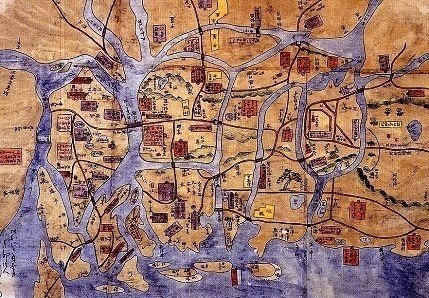
As for artificial defence, it was guarded with moats, earthworks, and earthen walls. Quintuple of fences and wooden barricades surrounded the area. Furthermore around the castle, 51 redoubts were built at strategic points.
Osaka Honganji was a grand network of fortress.
War on Honganji
Nobunaga's war on Honganji began in 1570 when he marched his army in the north of Osaka to attack enemy warlords, Miyoshi, Honganji suddenly made uprising against Nobunaga who was to retreat to Kyoto.
The war soon spread in and beyond Nobunaga's land. Honganji's chief priest, Kennyo(1543-1592) called for uprising against Nobunaga to branch temples of Honganji across Japan. The branch temples were in Nobunaga's land; one of the strongholds was Ise Nagashima which had resisted the samurai's rule.
Nobunaga attacked Nagashima in 1571 and 1573, but was both times repulsed. In 1574 he led his army of 30,000 and navy to besiege Nagashima from sea and land, blocked the connection to Osaka, Nobunaga was resolved to annihilate the enemy. Many of the believers in the temple starved to death, others got out to surrender, but Nobunaga did not allow them; mercilessly massacred; 20,000 believers died. The massacre of Nagashima frightened Osaka. Furthermore, Nobunaga made military campaign in 1575 in Echizen, northern coastal province, where he massacred 12,250 Buddhist believers[1].
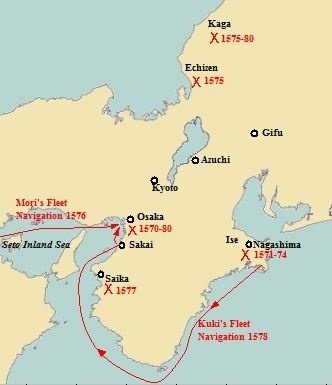
Furthermore Nobunaga's army marched north to capture the southern half of Kaga Province which had been ruled by Honganji believers.
Siege of Osaka
Honganji attacked Nobunaga's troops stationed at Osaka in June 1576, and defeated it. Honganji troops chased Nobunaga's troops which fled to the redoubt at Tennoji, south of Osaka, which was besieged by the Honganji Troops.
Nobunaga receiving the news in Kyoto, soon set off with the troops of only 3,000 men to rescue the Tennoji redoubt. Facing the enemy of 15,000 believers with 2,000 guns, Nobunaga was shot at the leg, but advanced his troops to communicate with the Tennoji troops to make simultaneous attack, and repulsed Honganji troops, chased them to Osaka castle gate, while they killed 2,700 Honganji believers.
Nobunaga, however, did not attack the Osaka Castle. He ordered his troops to build 10 redoubts around Osaka to surround the Honganji from north, east and south. The west was blocked by Nobunaga's fleet.
Honganji chief priest, Kennyo, called for help to the allies across Japan. Mori Terumoto, the powerful warlords in the western Japan, sent 600 boats escorted by 300 military vessels to Osaka in August 1576. They defeated Nobunaga's fleet of 200 vessels at Osaka bay and succeeded in supplying Osaka with food.
But two years later, in 1578, Nobunaga's Navy was reinforced by Kuki's fleet to block the Osaka Bay. That made Mori's second attempt in the year to supply Osaka a failure,
Honganji had 51 redoubt around Osaka to reinforce the defence, but they were captured by Nobunaga's troops one after another. The branch temples in the provinces around Osaka subjected to Nobunaga's rule. Honganji's allied warlords were losing power to stand against Nobunaga.
Fall of Osaka
The siege dragged on for four year, In 1580, though Osaka had no hope of support from outside, the castle still stood firm against Nobunaga's siege army.
Nobunaga did not capture the castle by force; he sought to make an armistice by the arbitration of the Imperial court,
In April 1580, Nobunaga submitted a letter of pledge to Honganji, with which Nobunaga required Honganji to leave Osaka by 14th of August, while guaranteeing the believers' lives. Meanwhile, he ordered ceasefire to his army at Osaka and in other provinces, and lifted the blockades to Osaka by land and sea.
But Nobunaga still continued war in Kaga province where his army captured the branch temple of Honganji and ruled the province. That made Osaka skeptical of Nobunaga's intention. Honganji was divided into two parties; one led by the chief priest, Kennyo, agreed to Nobunaga's request, but the other led by his son, Kyonyo(1558-1614), opposed.
Kennyo left Osaka in May carrying the image of the first Honganji Prist, Shinran, to Saika.
Kyonyo, after his father left, continued to resist against Nobunaga. As a new chief priest, he sent letters to the branch temples across Japan for the support of Osaka, but many of them had already submitted to Nobunaga's force. The redoubts around Osaka fell one after another to Nobunaga's army.
Meanwhile, in August Nobunaga issued the revised terms of armistice, in that he extended the deadline for evacuation to the 28th of September, while securing the lives of the residents in the towns.
Kyonyo finally agreed to the armistice. Thousands of Honganji believers were picked up by boats coming from Awaji Island and Saika, and traveled away on the roads.
Before they left, they made the temple tidy; maintenance and cleaning were conducted. at the front weapons like bows, spears, firearms, are hanged in line, inside, materials and goods are checked and neatly placed. That was the procedure to hand it over to the imperial officers. But then a fire broke out. All the buildings were burnt down in the following days and nights. Some accounts read that the fire was planned by Honganji[2][5], Was that their intention to make the fortress useless? On the other hand, Ota Guichi writes that it was caused by accident; the westerly wind blows over the torch fire[1].
In any reason, the Osaka Honganji flared up, billowing huge black cloud. That moment represented the end not only of the four years of the siege, ten years of Nobunaga's war on Honaganji, but also of a hundred years of warfare in which Buddhism powers challenged the samurai rules.
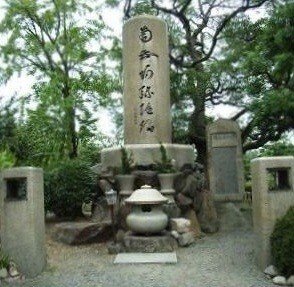
References
[1] 信長公記, 太田牛一
[2]多聞院日記. 三, 多聞院英俊 天正8年8月5日 p69/245
[3]織田信長 石山本願寺合戦全史―顕如との十年戦争の真実, 2002, 武田 鏡村
[4]石山合戦配陣図
[5]家忠日記 第2, 松平家忠 p18/72
Nobunaga On Canvas
https://nobunagaoncanvas.blogspot.com/2022/01/the-burning-of-honganji-temple-11.html
